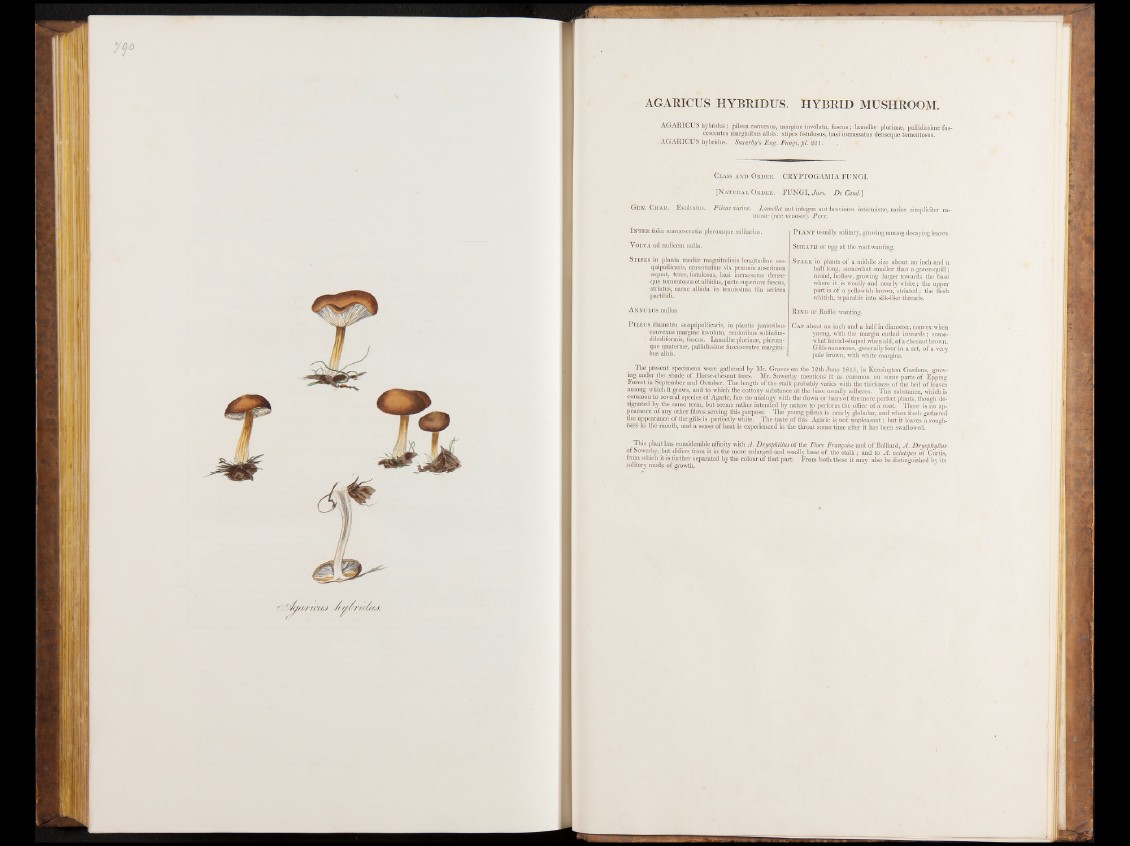
Oyma/y-ccaj
AGARIC US HYBRIDUS. HYBRID MUSHROOM.
AGARIGUS hybridus ; pileus cortvexus, margine involuta, fuscus ; laraellæ plurimæ, pallidissirae fus-
cescentes marginibus albis : stipes fistulosus, basi incrassatus denseque tomentosus.
AGARICÜS hybridus. Sozoerby's Eng. Fungi, pi. 221.
Class and Order. CRYPTOGAMIA FU N G I.
[N atural Order. FU N G I, Juss. D e Cand.]
Gen . Char. Evolvatus. Pileus varius. Lamellae aut intégras aut breviores intermistæ, rarius simpliciter ra-
mosæ (nec venosae). Pers.
Inter folia marcescentia plerumque solitarius.
Volva ad radicem nulla.
Stipes in planta media; magnitudinis longitudine ses-
quipollicaris, crassitudme vix pennam anserinam
æquat, teres, fistulosus, basi incrassatus denseque
tomentosus et albidus, parte superiore fuscus,
striatus, came albida in tenuissima fila sericea
partibili.
Annulus nullus.
Pileus diametro sesquipollicaris, in plantis junioribus
convexus margine involute, senioribus subinfun-
dibuliformis, fuscus. Lamellæ plurimæ, plerum- j
que quaternæ, pallidissime fuscescentes marginibus
albis.
Plant usually solitary, growing among decaying leaves.
Sheath or egg at the root wanting.
Stalk in plants of a middle size about an inch and a
half long, somewhat smaller than a goose-quill;
round, hollow, growing larger towards the base
where it is woolly and nearly white; the upper
partis of a yellowish brown, striated; the flesh
whitish, separable into silk-like threads.
Ring or Ruffle wanting.
Cap about an inch and a half in diameter, convex when
young, with the margin curled inwards; somewhat
funnel-shaped when old, of a chesnut brown.
Gills numerous, generally four in a set, of a very
pale brown, with white margins.
The present specimens were gathered by Mr. Graves on the 12th June 1-815, in Kensington Gardens, growin
g under the shade of Horse-chesnut trees. Mr. Sowerby mentions it as common on some parts of Epping
Forest in Sjeptember and October.. The length of the stalk probably varies with the thickness of the bed of leaves
among which it grows, and to which the cottony substance at the base usually adheres. This substance, which is
common to several species of Agaric, has no analogy with the down or hairs of the more perfect plants, though designated
by the same term, but seems rather intended by nature to perform the office of a root. There is no appearance
of any other, fibres serving this purpose. The young pileus is nearly globular, and when fresh gathered
the appearance of the gills is perfectly white. The taste of this Agaric is not unpleasant ; but it leaves a roughness
in the mouth, and a sense of heat is experienced in the throat some time after i t has been swallowed.
This plant has considerable affinity with A . Dryophillus of the Flore Françoise and of Bulliard, A . Dryophyllus
of Sowerby, but differs from it in the more enlarged and woolly base o f the stalk; and to A . velutipes of Curtis,
from which i t is further separated by the colour of that part. From both these it may also be distinguished by its
solitary mode-of growth.